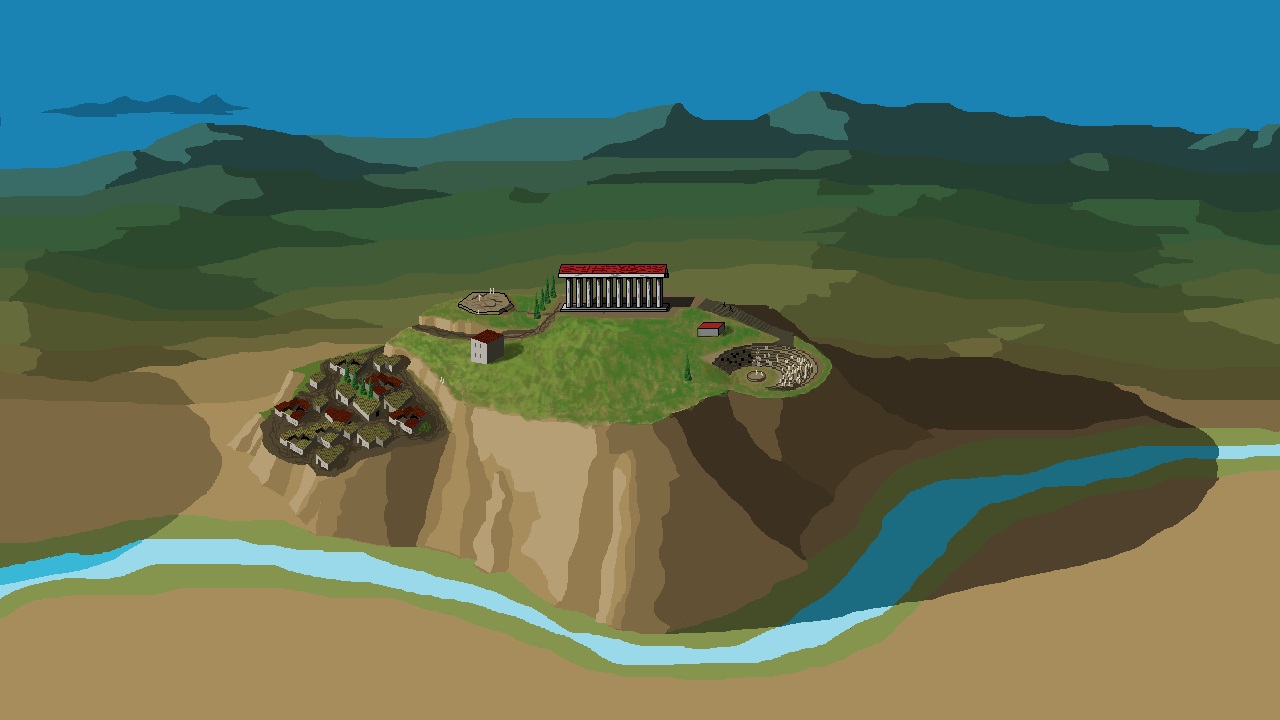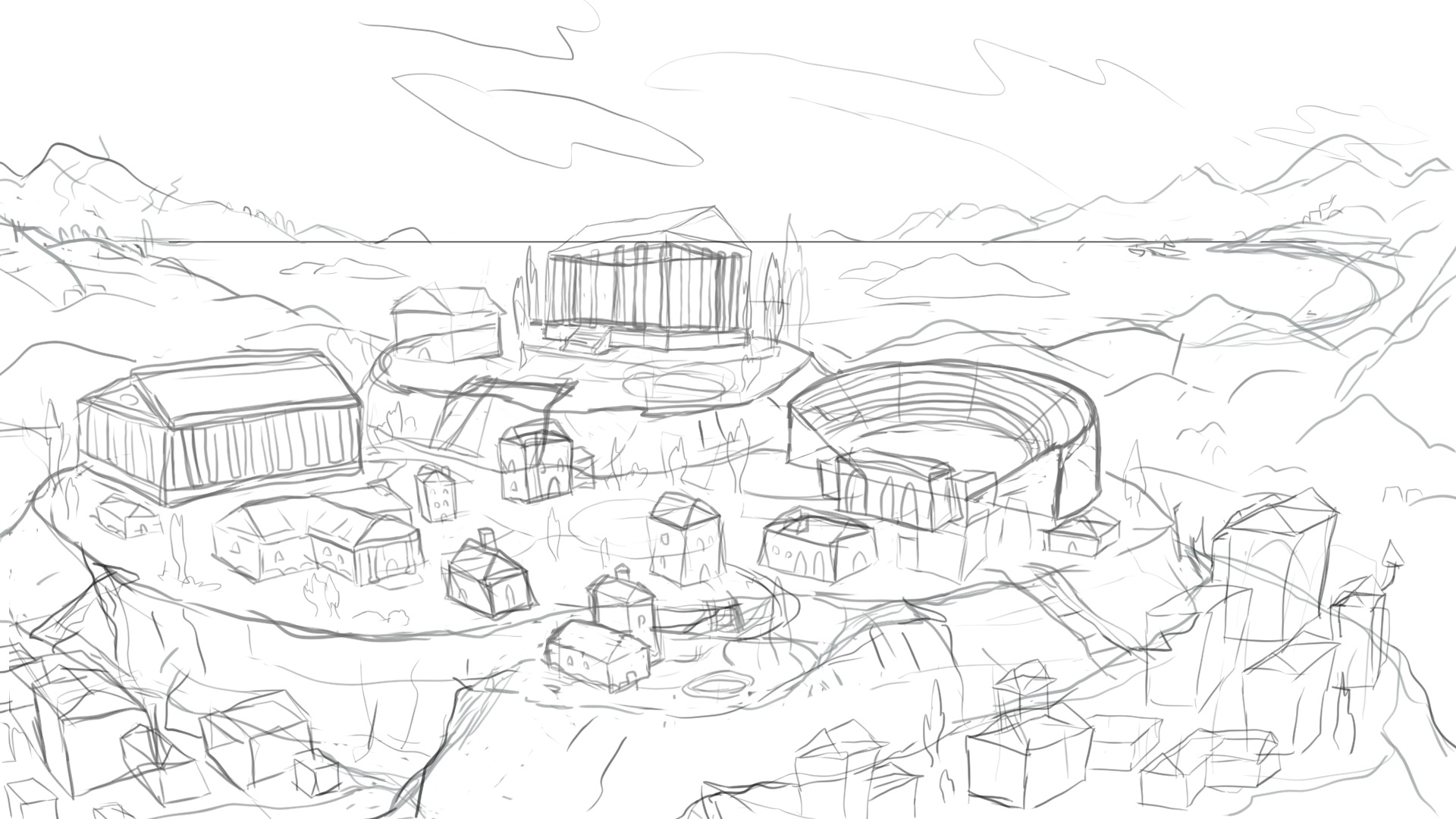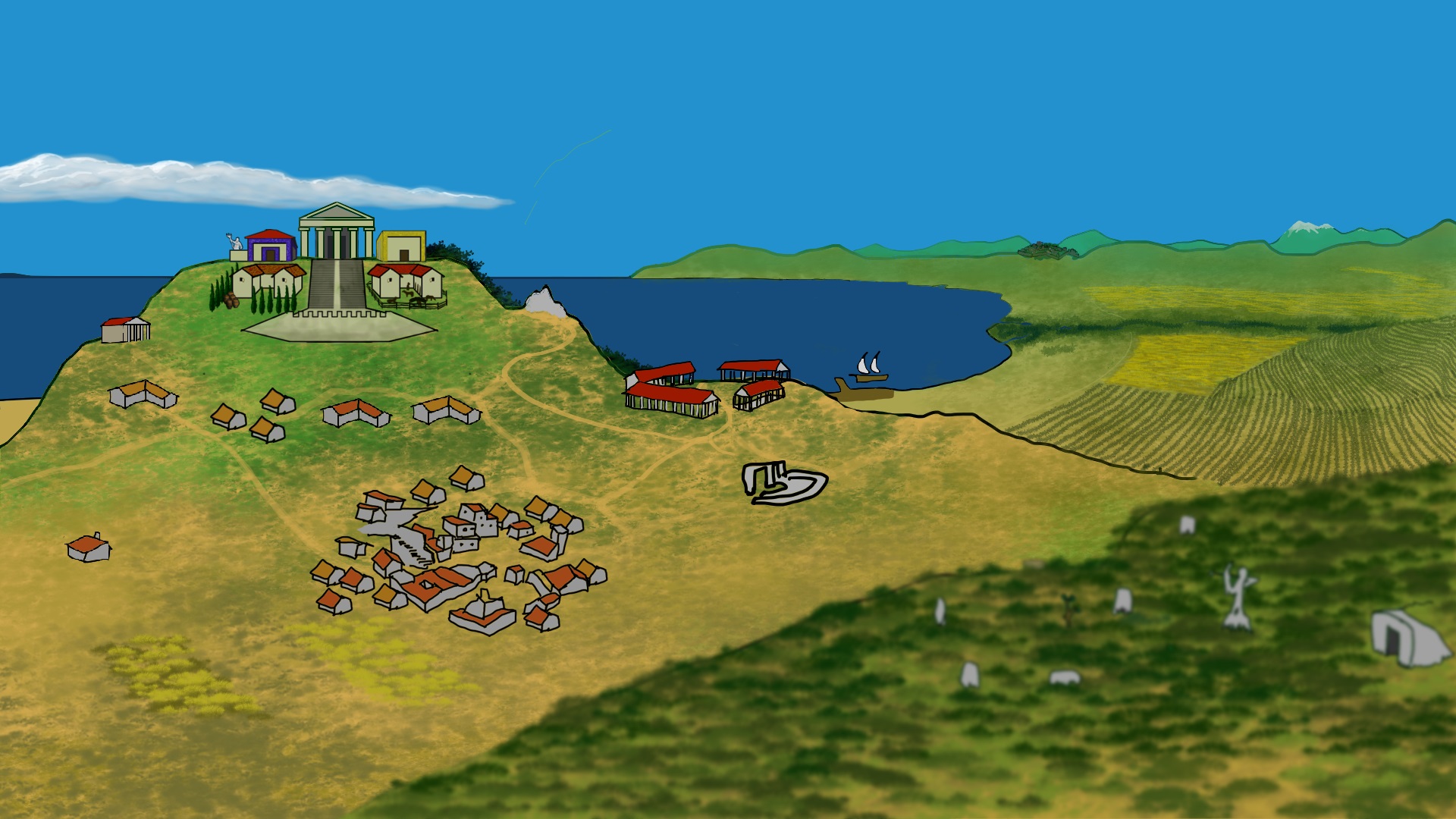Milestone: We got our ancient Greek city image!
Hi there, friends and foes of democracy,
I am currently developing Socratic Democracy from a humble prototype to a fully developed game. In this process, all the assets are being remade by me and a team of artists.
This devlog celebrates a milestone: we have just finished drawing the image below, which represents the fictitious ancient city of Foititia, where the game happens. (Well… we will still touch it here and there, but this is basically it).

This is the most important art asset of the game. It contains all the scenarios the player can visit: the theater, the agora, the port, the acropolis… As you can imagine, it was a lot of work.
Part of my celebration is to share my experience with y’all, fellow gamedevs. The rest of this devlog describes our process, but you can check this short youtube video to get a sense of it.
Background
Originally, Socratic Democracy was a little educational project of mine, something fun I made for my students—I teach politics at a university.
When I solodev’d the prototype in late 2020, the art was minimalistic. I draw the simplest ancient Greek city that I could conceive. Without any research or conceptualization, without a real plan, I made the drawings in a few days. Here is what I got for the main city view:

Looking back now, I am baffled by my ignorance. I thought the ancient Greek agora, the place where citizens met, was in the acropolis, that is, on the top of the mountain. I had many other misconceptions.
But I loved my little project, and I kept getting positive reactions to it, from students, gamedevs and outsiders. Eventually, I decided to make the project bigger and better.
I know many of you, fellow gamedevs, have been in the same position as I was. A little game gets some positive reaction, and you decide to make it real. Many of you continue to solodev the larger project, learning the necessary skills on the way. But I couldn’t do it. Drawing is not something you can master in a few weeks or months.
So, I decided to hire some artists.
Building a team of artists
Andrea Yepez, a student of digital animation at my university (USFQ), joined the project in late 2021. Back then, I was unable to give her any real guidance on how to draw the city. I had too many misconceptions and was lacking a real definition of how the improved game would be. Despite my paltry instructions, Andrea made a very good draft of the city. Her drawing also included a great idea: to place the city next to the sea.

As I worked with Andrea, I noticed the project was not as I once thought. I began to realize that a fully fleshed out story would require many more scenarios, scenes, animations, and characters than I told her at first. But Andrea was approaching her capstone project, and she wouldn´t be able to work more hours than we had agreed at first. Thus, I needed to increase the artistic team.
Last year, coming back from a friend´s party, I happened to share a cab with Bogar Chancay, a digital painter. A few weeks later, we found ourselves working together on a little game for the Gamejam Ecuador 2022. It was great to interact in this semi-professional environment. We had a great time and made a cute little functional game. I learned that Bogar, together with his brother, Gabriel, had formed Estudio Monocromo, and had already worked on diverse artistic projects, including in the games industry, for years. Quality stuff. Thankfully, Bogar liked my project too. However, it was clear that, to hire their professional hands, I would need to improve my documentation by many orders of magnitude.
And so, I did. I wrote documents describing the game, its scenarios, the scenes, and the cutscenes, events, options. I made a deep investigation of the architecture and urbanism of ancient Greek cities, discovering severe flaws in my previous understanding. I also made an image showing all the components of the city view, to guide their art:

In June, Monocromo agreed to join the project. I couldn’t be happier.
Making the art asset
With Monocromo and Andrea in my art team, I was able to separate functions: Andrea would work on the characters, Monocromo on the scenarios. The studio decided to focus all efforts on making the perfect city view, correctly understanding it would influence everything else. Gabriel Chancay, the line artist of Monocromo, made this first draft:

As you can see, they basically got it right in their first attempt. I was pleasantly shocked by their idea to display a curvature on the horizon, to mention one great idea. However, some elements were a bit hidden or too close to each other, In addition, I was still figuring out how the city should be viewed from smaller scenarios, such as the port or the cemetery. Thus, I began to ask for adjustments.
Unfortunately, this process was much harder than we thought. Changing the position of one element would interfere with elements nearby. The angle of one building could change the background of that element. Even the format of the mountain became an issue. Buildings of different sizes were laid in different distances and heights, creating a little nightmare to get proportions right. Each adjustment generated a chain reaction of problems. Everyone was getting frustrated.
We all knew we were in trouble, and so we looked for new solutions. I decided to consult and then hire Filipe Feijó, a multiartist and friend of mine, as codirector of art. For their part, Estudio Monocromo decided to build a 3D model to ease some of the difficulties we were facing.
It was hard, but it paid off. We eventually found a configuration that would make all scenarios visible, with the right space between them, good proportions, and correct background views. And so, they were able to make the next series of drafts, rapidly arriving at this beautiful and detailed image:

The next challenge was coloring it. We originally thought that the best idea was to render it like a 3D scene, with complex textures and light effects: shadows, reflections, complex light interactions... Estudio Monocromo showed they could implement this art style in about 48 hours, which is a good pace. And yet…
Each of us noticed some issues with the 3D art. Estudio Monocromo noticed that the image was very complex, and argued against adding full shadows on the city buildings. Doing so would make the scene hard to read, especially when these buildings became interactive. On my part, I felt that realistic shadows were essential. Without realistic shadows, it felt as if the buildings were floating in midair.
But it was Filipe who noticed the most serious issues. Our desire to implement 3D realism was fighting against the coherence and readability of our art. As one part of the scene became more realistic, other parts would have to follow suit. However, applying realistic textures in the background elements (such as the sea and the sky) was making it hard for the player to focus on what matters: the city.
(This is just a summary of the much more nuanced discussions we had back then).
In the end, we decided that the best art style is minimalistic. All shadows should appear, but without complex interactions or light bounces. Textures should be kept simple or hinted at by lines or color blocks. Coherence, readability, and beauty are more important than realism. And that is how we got the image we got.
Conclusion
Making this important art asset was, to use a Greek word, a marathon. But I think it was a huge success. Not only did we manage to create a very nice image, but we also found a great art style for the entire game.
I am very proud of the group of artists working at this project. I learned that Monocromo will take the extra mile to make the artwork, although I hope they won’t have to. I also confirmed that Filipe is great at art directing and will not let this project take a misstep. And while they work on the scenarios, Andrea keeps on creating an amazing cast of characters (I will soon write a devlog about it).
Even though I am surprised by how hard this process was, I have enjoyed every bit of it. And I feel like I have grown, not only as a gamedev, but also as a project leader and person. I am sure there is still a lot to learn, but I feel like, with this team, I can.
Cheers,
Pedro
Get Socratic Democracy
Socratic Democracy
Play as a politician in an ancient greek city state called Foititia.
| Status | Prototype |
| Author | pedrorns |
| Genre | Educational, Simulation |
| Tags | ancient-greece, based-on-a-book, democracy, Godot, philosophy, Point & Click, politics, Short |
| Languages | English, Spanish; Latin America, Portuguese (Brazil) |
More posts
- Presenting Dimitria, the first oligarch designed14 days ago
- Scenario Test45 days ago
- The cemetery55 days ago
- The Library90 days ago
- Improving the city. Part II: Adding remaining elements97 days ago
- Improving the city. Part I: GreeknessMar 19, 2025
- One year in the life of an ancient Greek city (new video)Feb 17, 2025
- Presenting the main charactersJul 02, 2024
- Poor Neighborhood: where campaigns take formJun 25, 2024
- Making the AgoraJun 03, 2024
Leave a comment
Log in with itch.io to leave a comment.